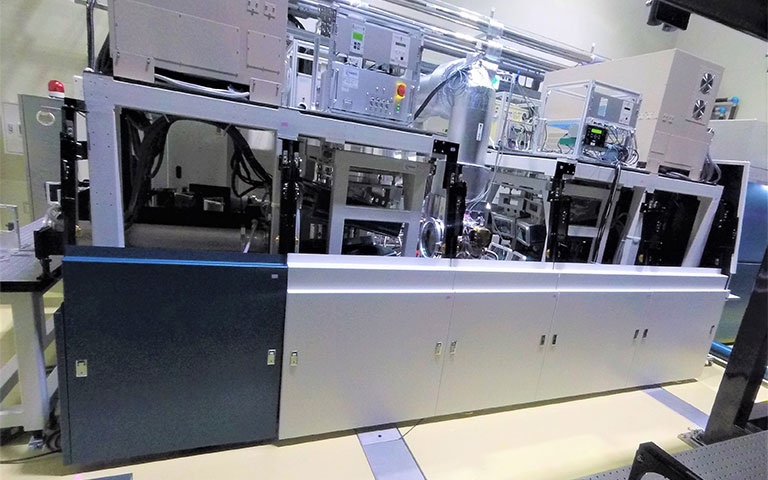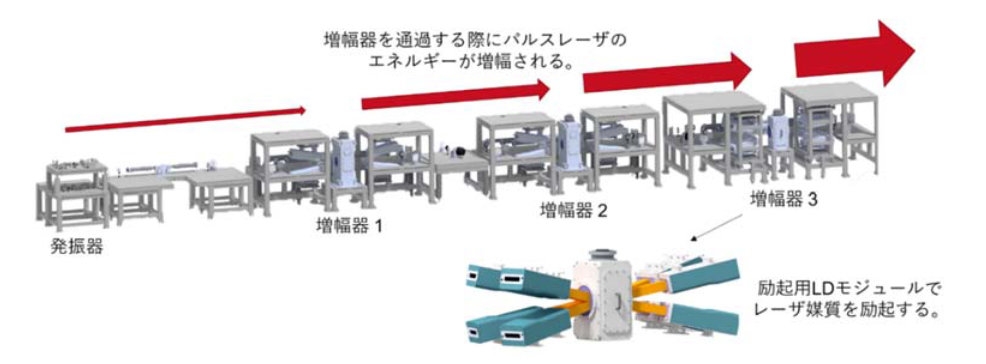

The laser energy is increased from 1 μJ to 100 J by an amplifier and output (Source: Hamamatsu Photonics)
Pulse laser device: Outputs a repetition frequency of 10Hz!
– Hamamatsu Photonics has succeeded in achieving higher frequencies for nuclear fusion! ー
Hamamatsu Photonics:
ーToward the practical application of “laser fusion”ー
We have developed a high-power pulsed laser device that causes nuclear fusion by laser irradiation.
Manufactured device:
We succeeded in “outputting a pulsed laser with a maximum of 100J at a repetition frequency of 10Hz”.
“There is a possibility that the average output can be increased by expanding the scale of the equipment.”
Device features:
“Laser energy output at 10 Hz from the oscillator” is amplified from 1 μJ to 100 J.
Output with an average output of 1 kW.
Semiconductors for excitation:
-Optimization of laser module-
In general, increasing the frequency “increases the temperature of the laser medium and reduces the laser amplification performance.”
Therefore, we reviewed the cooling system.
The output of the laser module was optimized to suppress the temperature rise of the laser medium.
Practical application of laser fusion:
In practical use of laser fusion, it is necessary to irradiate 1 MJ/pulse laser at a repetition frequency of 10 Hz.
Developed by Hamamatsu Photonics:
In 2021, we will successfully develop a “250J, 0.2Hz device (average output 50W)” jointly with NEDO.
In the future, we will “establish 250J, 10Hz technology” and aim for “1kJ, 10Hz as an intermediate goal”.
Nikkei Cross Tech (xTECH)
https://xtech.nikkei.com/atcl/nxt/news/18/14478/
L’énergie laser est augmentée de 1 μJ à 100 J par un amplificateur et une sortie (Source : Hamamatsu Photonics)
Appareil laser à impulsions : produit une fréquence de répétition de 10 Hz !
– Hamamatsu Photonics a réussi à atteindre des fréquences plus élevées pour la fusion nucléaire ! ー
Photonique Hamamatsu :
ーVers l’application pratique de la “fusion laser”ー
Nous avons développé un dispositif laser pulsé de haute puissance qui provoque la fusion nucléaire par irradiation laser.
Appareil fabriqué :
Nous avons réussi à “sortir un laser pulsé avec un maximum de 100J à une fréquence de répétition de 10Hz”.
“Il est possible que la production moyenne puisse être augmentée en élargissant l’échelle de l’équipement.”
Caractéristiques de l’appareil :
“La sortie d’énergie laser à 10 Hz de l’oscillateur” est amplifiée de 1 μJ à 100 J.
Sortie avec une puissance moyenne de 1 kW.
Semi-conducteurs pour l’excitation :
-Optimisation du module laser-
En général, l’augmentation de la fréquence “augmente la température du milieu laser et réduit les performances d’amplification du laser”.
Par conséquent, nous avons revu le mécanisme de refroidissement.
La sortie du module laser a été optimisée pour supprimer l’augmentation de température du milieu laser.
Application pratique de la fusion laser :
Dans l’utilisation pratique de la fusion laser, il est nécessaire d’irradier 1 MJ/impulsion laser à une fréquence de répétition de 10 Hz.
Développé par Hamamatsu Photonics :
En 2021, nous développerons avec succès un « appareil 250J, 0,2 Hz (sortie moyenne 50 W) » conjointement avec NEDO.
À l’avenir, nous allons “établir la technologie 250J, 10Hz” et viser “1kJ, 10Hz comme objectif intermédiaire”.
Nikkei CrossTech (xTECH)
Die Laserenergie wird durch einen Verstärker von 1 μJ auf 100 J erhöht und ausgegeben (Quelle: Hamamatsu Photonics)
Impulslasergerät: Gibt eine Wiederholfrequenz von 10Hz aus!
– Hamamatsu Photonics ist es gelungen, höhere Frequenzen für die Kernfusion zu erreichen! ー
Hamamatsu-Photonik:
ーAuf dem Weg zur praktischen Anwendung der „Laserfusion“ー
Wir haben ein gepulstes Hochleistungslasergerät entwickelt, das durch Laserbestrahlung eine Kernfusion bewirkt.
Hergestelltes Gerät:
Es ist uns gelungen, „einen gepulsten Laser mit maximal 100 J bei einer Wiederholfrequenz von 10 Hz auszugeben“.
“Es besteht die Möglichkeit, dass die durchschnittliche Leistung erhöht werden kann, indem der Umfang der Ausrüstung erweitert wird.”
Geräteeigenschaften:
“Laserenergieabgabe bei 10 Hz vom Oszillator” wird von 1 μJ auf 100 J verstärkt.
Leistung mit einer durchschnittlichen Leistung von 1 kW.
Halbleiter zur Anregung:
-Optimierung Lasermodul-
Im Allgemeinen erhöht das Erhöhen der Frequenz “die Temperatur des Lasermediums und verringert die Laserverstärkungsleistung”.
Daher haben wir den Kühlmechanismus überprüft.
Die Leistung des Lasermoduls wurde optimiert, um den Temperaturanstieg des Lasermediums zu unterdrücken.
Praktische Anwendung der Laserfusion:
Bei der praktischen Anwendung der Laserfusion ist es erforderlich, 1 MJ/Pulslaser mit einer Wiederholungsfrequenz von 10 Hz einzustrahlen.
Entwickelt von Hamamatsu Photonics:
Im Jahr 2021 werden wir gemeinsam mit NEDO erfolgreich ein „250J, 0,2Hz-Gerät (durchschnittliche Leistung 50W)“ entwickeln.
In Zukunft werden wir „250J, 10Hz Technologie etablieren“ und „1kJ, 10Hz als Zwischenziel“ anstreben.
Nikkei Cross Tech (xTECH)
Hamamatsu Photonics has succeeded in producing laser pulses with energy of 100J at a high repetition rate of 10Hz
Hamamatsu Photonics
has succeeded in producing laser pulses with energy of 100 joules (J) at a high repetition rate of 10 hertz (Hz).
This was achieved
by increasing the cooling capacity for the laser medium (*1) of the pulsed laser system and by optimizing the output of the laser diode (LD) module for pumping (*2).
To make laser fusion practical,
the fusion fuel needs to be efficiently irradiated with a pulsed laser
that produces as much as 1 megajoule (MJ) at a high repetition rate of 10 Hz.
We believe that establishing
this technology is an important milestone where the results from this study will help us move toward this goal.
We will present the results of this study at a symposium and general lecture at the “43rd Annual Meeting of the Laser Society of Japan” to be held at WINC AICHI (Nakamura-ku, Nagoya, Japan) from the 18th to the 20th January 2023.
*1: Laser medium is a material that stores energy from an outside source and amplifies the laser passing through it by imparting energy to the laser.
Hamamatsu Photonics
https://www.hamamatsu.com/jp/en/news/products-and-technologies/2023/20230112000000.html